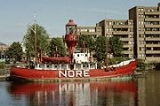
Lightvessels in the United Kingdom
Encyclopedia
The history of Lightvessels in the United Kingdom goes back over 250 years. This page also gives a list of lightvessel
stations within the United Kingdom
, the Channel Islands
and Gibraltar
.
and ship manager from King's Lynn
, and David Avery, a projector and inventor. Securing a patent on the technology they had developed, Avery had a lightvessel placed at the Nore
in the Thames mouth in 1731, against the wishes of the lighthouse authority Trinity House
, who considered the scheme worthless and the two men to be little more than adventurers. The lightvessel proved to be a great success, and Trinity House moved to acquire the patent themselves, granting Avery lease revenues in exchange. A further lightvessel was placed at the Dudgeon station, off the Norfolk
coast, in 1736, with others following at Owers (1748) and Newarp (1790). Many others were commissioned during the nineteenth century, especially off England's east coast and the approaches to the Thames, where there were many treacherous shoal
s.
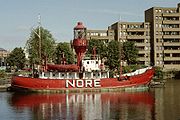 Following their acquisition of the patent, all English and Welsh lightvessels were maintained by Trinity House, with the exception of the four vessels in the approaches to the River Mersey
Following their acquisition of the patent, all English and Welsh lightvessels were maintained by Trinity House, with the exception of the four vessels in the approaches to the River Mersey
, which were maintained by the Mersey Docks and Harbour Board until 1973, and those in the Humber Estuary, which were the responsibility of the Humber Conservancy Board. In order to act as effective daymark
s Trinity House lightvessels were painted red, with the station name in large white letters on the side of the hull, and a system of balls and cones at the masthead for identification. The first revolving light was fitted to the Swin Middle lightvessel in 1837: others used occulting or flashing lights. White lights were preferred for visibility though red and very occasionally green (as with the Mouse
lightvessel) were also used.
on shore. After a series of shipwrecks, an experiment was conducted whereby a nine-mile undersea cable was run from the Sunk lightvessel in the Thames Estuary
to the post office
at Walton-on-the-Naze
. This was intended to commence in 1884, but was plagued by delays; the trial was unsuccessful as the cable repeatedly broke. As a result of a motion brought forward by Sir Edward Birkbeck, a Royal Commission
was established to look at the issue of 'electrical communication' and gave its first Report in 1892; the East Goodwin lightvessel was used during one of Guglielmo Marconi
's early experiments in radio transmission in 1896. The world's first radio distress signal was transmitted by the East Goodwin lightvessel's radio operator on 17 March 1899, after the merchant vessel
Elbe ran aground on the Goodwins
, while on 30 April that year, the East Goodwin vessel transmitted a distress signal on its own behalf, when the SS R. F. Matthews rammed it in a dense fog. Safety was further improved by the development of more powerful lamps and through the replacement by foghorn
s of the gong
s previously used as fog signals.
described lightshipmen as being paid 55 shillings a month (in addition to drawing 1 shilling and sixpence a week "in lieu of 3 gallons of small-beer"): the vessels were supplied, and the crews relieved, once a month. It was also noted that "a general tone of decent, orderly and superior conduct" was observed, that the men were "very respectable [...] swearing and profane language are [...] prohibited" and that every man was supplied with a bible as well as "a library of varied and entertaining literature".
By the start of the 20th century, Trinity House lightvessels had a crew of 11, of whom 7 (a master and 6 ratings) would be on active duty at any one time. It was an extremely demanding and dangerous profession, and it would take 15 to 20 years of service to be promoted to master.
buoys, which were vastly cheaper to maintain: at the time of Trinity House's original project to develop LANBY buoys, a lightship cost £30,000 annually (at 1974 prices) to maintain, whereas a buoy cost £3,000.
The remaining UK lightvessels have now been converted to unmanned operation and most now use solar power
.
s.
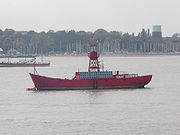
, with the exception of one maintained by the Clyde Lighthouse Trust. Only the North Carr station was manned.
Lightvessel
A lightvessel, or lightship, is a ship which acts as a lighthouse. They are used in waters that are too deep or otherwise unsuitable for lighthouse construction...
stations within the United Kingdom
United Kingdom
The United Kingdom of Great Britain and Northern IrelandIn the United Kingdom and Dependencies, other languages have been officially recognised as legitimate autochthonous languages under the European Charter for Regional or Minority Languages...
, the Channel Islands
Channel Islands
The Channel Islands are an archipelago of British Crown Dependencies in the English Channel, off the French coast of Normandy. They include two separate bailiwicks: the Bailiwick of Guernsey and the Bailiwick of Jersey...
and Gibraltar
Gibraltar
Gibraltar is a British overseas territory located on the southern end of the Iberian Peninsula at the entrance of the Mediterranean. A peninsula with an area of , it has a northern border with Andalusia, Spain. The Rock of Gibraltar is the major landmark of the region...
.
History
The world's first lightvessel was the result of a business partnership between Robert Hamblin, an impoverished former barberBarber
A barber is someone whose occupation is to cut any type of hair, and to shave or trim the beards of men. The place of work of a barber is generally called a barbershop....
and ship manager from King's Lynn
King's Lynn
King's Lynn is a sea port and market town in the ceremonial county of Norfolk in the East of England. It is situated north of London and west of Norwich. The population of the town is 42,800....
, and David Avery, a projector and inventor. Securing a patent on the technology they had developed, Avery had a lightvessel placed at the Nore
Nore
The Nore is a sandbank at the mouth of the Thames Estuary, England. It marks the point where the River Thames meets the North Sea, roughly halfway between Havengore Creek in Essex and Warden Point in Kent....
in the Thames mouth in 1731, against the wishes of the lighthouse authority Trinity House
Trinity House
The Corporation of Trinity House of Deptford Strond is the official General Lighthouse Authority for England, Wales and other British territorial waters...
, who considered the scheme worthless and the two men to be little more than adventurers. The lightvessel proved to be a great success, and Trinity House moved to acquire the patent themselves, granting Avery lease revenues in exchange. A further lightvessel was placed at the Dudgeon station, off the Norfolk
Norfolk
Norfolk is a low-lying county in the East of England. It has borders with Lincolnshire to the west, Cambridgeshire to the west and southwest and Suffolk to the south. Its northern and eastern boundaries are the North Sea coast and to the north-west the county is bordered by The Wash. The county...
coast, in 1736, with others following at Owers (1748) and Newarp (1790). Many others were commissioned during the nineteenth century, especially off England's east coast and the approaches to the Thames, where there were many treacherous shoal
Shoal
Shoal, shoals or shoaling may mean:* Shoal, a sandbank or reef creating shallow water, especially where it forms a hazard to shipping* Shoal draught , of a boat with shallow draught which can pass over some shoals: see Draft...
s.

River Mersey
The River Mersey is a river in North West England. It is around long, stretching from Stockport, Greater Manchester, and ending at Liverpool Bay, Merseyside. For centuries, it formed part of the ancient county divide between Lancashire and Cheshire....
, which were maintained by the Mersey Docks and Harbour Board until 1973, and those in the Humber Estuary, which were the responsibility of the Humber Conservancy Board. In order to act as effective daymark
Daymark
A daymark or a day marker is a structure such as a tower constructed on land as an aid to navigation by sailors. While similar in concept to a lighthouse, a daymark does not have a light and so is usually only visible during daylight hours...
s Trinity House lightvessels were painted red, with the station name in large white letters on the side of the hull, and a system of balls and cones at the masthead for identification. The first revolving light was fitted to the Swin Middle lightvessel in 1837: others used occulting or flashing lights. White lights were preferred for visibility though red and very occasionally green (as with the Mouse
Mouse
A mouse is a small mammal belonging to the order of rodents. The best known mouse species is the common house mouse . It is also a popular pet. In some places, certain kinds of field mice are also common. This rodent is eaten by large birds such as hawks and eagles...
lightvessel) were also used.
Communications and safety
Communication with lightvessels proved to be a major problem for Trinity House; lightvessel crews were well-placed to observe ships in distress, but could not always alert lifeboatsRoyal National Lifeboat Institution
The Royal National Lifeboat Institution is a charity that saves lives at sea around the coasts of Great Britain, Ireland, the Channel Islands and the Isle of Man, as well as on selected inland waterways....
on shore. After a series of shipwrecks, an experiment was conducted whereby a nine-mile undersea cable was run from the Sunk lightvessel in the Thames Estuary
Thames Estuary
The Thames Mouth is the estuary in which the River Thames meets the waters of the North Sea.It is not easy to define the limits of the estuary, although physically the head of Sea Reach, near Canvey Island on the Essex shore is probably the western boundary...
to the post office
Post office
A post office is a facility forming part of a postal system for the posting, receipt, sorting, handling, transmission or delivery of mail.Post offices offer mail-related services such as post office boxes, postage and packaging supplies...
at Walton-on-the-Naze
Walton-on-the-Naze
Walton-on-the-Naze is a small town in Essex, England, on the North Sea coast in the Tendring district. It is north of Clacton and south of the port of Harwich. It abuts Frinton-on-Sea to the south, and is part of the parish of Frinton and Walton. It is a resort town, with a permanent population of...
. This was intended to commence in 1884, but was plagued by delays; the trial was unsuccessful as the cable repeatedly broke. As a result of a motion brought forward by Sir Edward Birkbeck, a Royal Commission
Royal Commission
In Commonwealth realms and other monarchies a Royal Commission is a major ad-hoc formal public inquiry into a defined issue. They have been held in various countries such as the United Kingdom, Australia, Canada, New Zealand, and Saudi Arabia...
was established to look at the issue of 'electrical communication' and gave its first Report in 1892; the East Goodwin lightvessel was used during one of Guglielmo Marconi
Guglielmo Marconi
Guglielmo Marconi was an Italian inventor, known as the father of long distance radio transmission and for his development of Marconi's law and a radio telegraph system. Marconi is often credited as the inventor of radio, and indeed he shared the 1909 Nobel Prize in Physics with Karl Ferdinand...
's early experiments in radio transmission in 1896. The world's first radio distress signal was transmitted by the East Goodwin lightvessel's radio operator on 17 March 1899, after the merchant vessel
Merchant vessel
A merchant vessel is a ship that transports cargo or passengers. The closely related term commercial vessel is defined by the United States Coast Guard as any vessel engaged in commercial trade or that carries passengers for hire...
Elbe ran aground on the Goodwins
Goodwin Sands
The Goodwin Sands is a 10-mile-long sand bank in the English Channel, lying six miles east off Deal in Kent, England. The Brake Bank lying shorewards is part of the same geological unit. As the shoals lie close to major shipping channels, more than 2,000 ships are believed to have been wrecked...
, while on 30 April that year, the East Goodwin vessel transmitted a distress signal on its own behalf, when the SS R. F. Matthews rammed it in a dense fog. Safety was further improved by the development of more powerful lamps and through the replacement by foghorn
Foghorn
A foghorn or fog signal or fog bell is a device that uses sound to warn vehicles of hazards or boats of the presence of other vehicles in foggy conditions. The term is most often used in relation to marine transport...
s of the gong
Gong
A gong is an East and South East Asian musical percussion instrument that takes the form of a flat metal disc which is hit with a mallet....
s previously used as fog signals.
Crew
Until the later 20th century, all Trinity House vessels were permanently manned. An 1861 article in the Cornhill MagazineCornhill Magazine
The Cornhill Magazine was a Victorian magazine and literary journal named after Cornhill Street in London.Cornhill was founded by George Murray Smith in 1860 and was published until 1975. It was a literary journal with a selection of articles on diverse subjects and serialisations of new novels...
described lightshipmen as being paid 55 shillings a month (in addition to drawing 1 shilling and sixpence a week "in lieu of 3 gallons of small-beer"): the vessels were supplied, and the crews relieved, once a month. It was also noted that "a general tone of decent, orderly and superior conduct" was observed, that the men were "very respectable [...] swearing and profane language are [...] prohibited" and that every man was supplied with a bible as well as "a library of varied and entertaining literature".
By the start of the 20th century, Trinity House lightvessels had a crew of 11, of whom 7 (a master and 6 ratings) would be on active duty at any one time. It was an extremely demanding and dangerous profession, and it would take 15 to 20 years of service to be promoted to master.
Replacement
The majority of British lightvessels were decommissioned during the 1970s - 1980s and replaced with light floats or LANBYLanby buoy
Lanby buoy is a contraction of Large Automatic Navigation BuoY. Lanby buoys were originally made by Hawker Siddeley Dynamics and were used from the 1970s onwards. The buoys are intended to replace lightships and are constructed as a circular hull with a central light to provide all-round visibility...
buoys, which were vastly cheaper to maintain: at the time of Trinity House's original project to develop LANBY buoys, a lightship cost £30,000 annually (at 1974 prices) to maintain, whereas a buoy cost £3,000.
The remaining UK lightvessels have now been converted to unmanned operation and most now use solar power
Solar power
Solar energy, radiant light and heat from the sun, has been harnessed by humans since ancient times using a range of ever-evolving technologies. Solar radiation, along with secondary solar-powered resources such as wind and wave power, hydroelectricity and biomass, account for most of the available...
.
Lightvessel stations
The following are lightvessel stations; i.e. a named position at which a lightvessel was placed, rather than the names of vessels themselves. Individual vessels were often transferred between different stations during their existence. Stations themselves were occasionally changed, especially during wartime, when lights were only displayed in response to specific shipping needs.Active lightvessel stations
The following are active stations at which Trinity House still maintains unmanned lightships, which also act as weather stationWeather station
A weather station is a facility, either on land or sea, with instruments and equipment for observing atmospheric conditions to provide information for weather forecasts and to study the weather and climate. The measurements taken include temperature, barometric pressure, humidity, wind speed, wind...
s.

- Channel LightvesselChannel Light Vessel AutomaticChannel Light Vessel Automatic is the name of a lightvessel in the English Channel. It is one of the 12 coastal weather stations whose conditions are automatically reported in the BBC Shipping Forecast. The vessel's position is .-External links:*...
- F3 Lightvessel (middle of English ChannelEnglish ChannelThe English Channel , often referred to simply as the Channel, is an arm of the Atlantic Ocean that separates southern England from northern France, and joins the North Sea to the Atlantic. It is about long and varies in width from at its widest to in the Strait of Dover...
, east of RamsgateRamsgateRamsgate is a seaside town in the district of Thanet in east Kent, England. It was one of the great English seaside towns of the 19th century and is a member of the ancient confederation of Cinque Ports. It has a population of around 40,000. Ramsgate's main attraction is its coastline and its main...
) - East Goodwin Lightvessel (Goodwin SandsGoodwin SandsThe Goodwin Sands is a 10-mile-long sand bank in the English Channel, lying six miles east off Deal in Kent, England. The Brake Bank lying shorewards is part of the same geological unit. As the shoals lie close to major shipping channels, more than 2,000 ships are believed to have been wrecked...
) - Greenwich LightvesselGreenwich Light Vessel AutomaticGreenwich Light Vessel Automatic is the name of a lightvessel in the English Channel, off the coast of East Sussex. It is one of the 12 coastal weather stations whose conditions are automatically reported in the BBC Shipping Forecast. The name of the vessel derives from the fact that is located on...
- Sandettie LightvesselSandettie Light Vessel AutomaticSandettie Light Vessel Automatic is the name of a lightvessel in the English Channel. It is one of the 12 coastal weather stations whose conditions are automatically reported in the BBC Shipping Forecast....
- Sevenstones LightvesselSevenstones LightshipThe Sevenstones Lightship is moored off the Seven Stones reef approximately 10 miles North East of the Isles of Scilly.-External links:**...
- Sunk Lightvessel (Thames EstuaryThames EstuaryThe Thames Mouth is the estuary in which the River Thames meets the waters of the North Sea.It is not easy to define the limits of the estuary, although physically the head of Sea Reach, near Canvey Island on the Essex shore is probably the western boundary...
) - Varne LightvesselVarne BankThe Varne Bank is a five and three quarter mile long sand bank in the Dover Straits, lying nine miles southwest of Dover in Kent, England.Lying almost in the middle of the south/west international traffic English-side channel of the English Channel, the Varne Bank is a constant concern for both Her...
Former lightvessel stations
- Bar (Mersey Estuary; maintained by MDHB)
- Barrow Deep (Barrow Deep channel, Thames Estuary)
- Black DeepBlack DeepThe Black Deep is a channel which forms the most important of the three main permanent shipping routes through the shoals in the Thames Estuary, the others being the Barrow Deep and Princes Channel....
(Thames Estuary) - Brake (Brake Sand, near Goodwin SandsGoodwin SandsThe Goodwin Sands is a 10-mile-long sand bank in the English Channel, lying six miles east off Deal in Kent, England. The Brake Bank lying shorewards is part of the same geological unit. As the shoals lie close to major shipping channels, more than 2,000 ships are believed to have been wrecked...
) - Bull (Bull Sands, mouth of the Humber Estuary; maintained by Humber Conservancy Board)
- Calshot SpitCalshot SpitCalshot Spit is a one-mile long sand and shingle bank, located on the southern bank of the open end of Southampton Water, on the south coast of England....
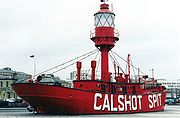
- Cockle (North Sea)
- Cork (Cork Bank, off HarwichHarwichHarwich is a town in Essex, England and one of the Haven ports, located on the coast with the North Sea to the east. It is in the Tendring district. Nearby places include Felixstowe to the northeast, Ipswich to the northwest, Colchester to the southwest and Clacton-on-Sea to the south...
) - Corton (North Sea)
- Crosby (Mersey Estuary; maintained by MDHB)
- Inner / Outer Dowsing (North Sea; Inner Dowsing was the last manned lightship station, replaced by the Dowsing lighthouse in 1991)
- Dudgeon (North Sea; the Dudgeon lightvessel was bombed by the LuftwaffeLuftwaffeLuftwaffe is a generic German term for an air force. It is also the official name for two of the four historic German air forces, the Wehrmacht air arm founded in 1935 and disbanded in 1946; and the current Bundeswehr air arm founded in 1956....
on 29 January 1940. Only one crew member, John Sanders, survived. The incident was the subject of a 1940 British Government propagandaPropagandaPropaganda is a form of communication that is aimed at influencing the attitude of a community toward some cause or position so as to benefit oneself or one's group....
film, Men of the Lightship. - Edinburgh (Thames Estuary; the name refers to the Edinburgh Channel)
- English and Welsh Grounds (Bristol ChannelBristol ChannelThe Bristol Channel is a major inlet in the island of Great Britain, separating South Wales from Devon and Somerset in South West England. It extends from the lower estuary of the River Severn to the North Atlantic Ocean...
) - Formby (Mersey Estuary, maintained by MDHB)
- Galloper (Galloper shoal, North Sea)
- Girdler (Thames Estuary)
- North / South GoodwinGoodwin SandsThe Goodwin Sands is a 10-mile-long sand bank in the English Channel, lying six miles east off Deal in Kent, England. The Brake Bank lying shorewards is part of the same geological unit. As the shoals lie close to major shipping channels, more than 2,000 ships are believed to have been wrecked...
(the South Goodwin vessel was driven onto the Goodwin Sands and wrecked during a severe storm on 27 November 1954, the first Trinity House ship to be lost in this manner. Ronald Murton was the only crew member to be rescued, after clinging to the ship's hull for eight hours) - Gull (marked the Gull Stream on the Goodwin Sands)
- Gunfleet (Gunfleet Sands, Thames Estuary; replaced by Gunfleet LighthouseGunfleet LighthouseGunfleet Lighthouse is a screw-pile lighthouse lying in the North Sea, six miles off the coast at Frinton-on-Sea in Essex constructed in 1850 by James Walker of Trinity House. It is 74 feet in height and hexagonal in plan; mounted on seven piles forming a steel lattice and originally painted red...
in 1850) - Hasborough (North Sea)
- Humber (maintained by Humber Conservancy Board)
- Kentish KnockKentish KnockKentish Knock may refer to:* Kentish Knock, an area off the coast of Kent and Essex in England* Battle of the Kentish Knock, fought in October 1652* London Array, a wind farm near the Kentish Knock....
- Knoll (Smith's Knoll, North Sea) off Norfolk
- Leman and Ower (North Sea)
- Longsand (Thames Estuary)
- Morecambe BayMorecambe BayMorecambe Bay is a large bay in northwest England, nearly due east of the Isle of Man and just to the south of the Lake District National Park. It is the largest expanse of intertidal mudflats and sand in the United Kingdom, covering a total area of 310 km².-Natural features:The rivers Leven,...
- Mouse (Mouse Sand, Thames Estuary)
- Nab (Straits of Dover; replaced by the Nab TowerNab TowerThe Nab Tower is a tower planned for anti-submarine protection in the Straits of Dover in World War I. It was sunk over the Nab rocks east of the Isle of Wight to replace a lightship after the war, and is a well known landmark for sailors as it marks the deep water eastern entry into the...
in 1920) - NoreNoreThe Nore is a sandbank at the mouth of the Thames Estuary, England. It marks the point where the River Thames meets the North Sea, roughly halfway between Havengore Creek in Essex and Warden Point in Kent....
(Thames Estuary; the world's first manned lightship, 1731) - Newarp (North Sea)
- Northwestern (Mersey Estuary, maintained by MDHB)
- Outer Gabbard (North Sea)
- Owers (Owers Bank, off Selsey BillSelsey BillSelsey Bill is a headland into the English Channel on the south coast of England in the county of West Sussex.The southern most town in Sussex is Selsey which is at the end of the Selsey Peninsula and Selsey Bill is situated on the towns southerncoastline...
). Replaced with a beacon. (LV Owers now a wreck in Tel AvivTel AvivTel Aviv , officially Tel Aviv-Yafo , is the second most populous city in Israel, with a population of 404,400 on a land area of . The city is located on the Israeli Mediterranean coastline in west-central Israel. It is the largest and most populous city in the metropolitan area of Gush Dan, with...
harbour). - Royal Sovereign (off EastbourneEastbourneEastbourne is a large town and borough in East Sussex, on the south coast of England between Brighton and Hastings. The town is situated at the eastern end of the chalk South Downs alongside the high cliff at Beachy Head...
; replaced with Royal Sovereign lighthouseRoyal Sovereign lighthouseRoyal Sovereign lighthouse at Eastbourne is a lighthouse marking the Royal Sovereign shoal. Its distinctive shape is easily recognised as it comprises a large platform supported by a single pillar rising out of the water....
1971) - Shambles (the Shambles Bank, off Portland BillPortland BillPortland Bill is a narrow promontory of Portland stone, which forms the most southerly part of Isle of Portland, and therefore also the county of Dorset, England....
) - Shipwash (North Sea, off HarwichHarwichHarwich is a town in Essex, England and one of the Haven ports, located on the coast with the North Sea to the east. It is in the Tendring district. Nearby places include Felixstowe to the northeast, Ipswich to the northwest, Colchester to the southwest and Clacton-on-Sea to the south...
) - Spurn (Spurn Head; maintained by Humber Conservancy Board. A former Spurn lightvesselSpurn LightshipThe Spurn Lightship is a lightvessel currently anchored in Hull Marina in the British city of Kingston upon Hull, England. The ship was built in 1927 and served for 48 years as a navigation aid in the approaches of the Humber Estuary, were it was stationed 4½ miles east of Spurn Point...
is preserved at Hull MarinaHull MarinaHull Marina is a marina for pleasure boats situated in the English city of Kingston upon Hull. It was opened in 1983 on the site of the former Railway dock and Humber docks....
)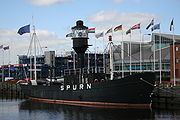
- Swin Middle (Swin Channel, Thames Estuary)
- Tongue (Tongue Sands, Thames Estuary)
- Well (outside The WashThe WashThe Wash is the square-mouthed bay and estuary on the northwest margin of East Anglia on the east coast of England, where Norfolk meets Lincolnshire. It is among the largest estuaries in the United Kingdom...
; replaced with buoy 1975) - Would (North Sea)
Scotland, Isle of Man
Lightvessels in Scotland and the Isle of Man were maintained by the Northern Lighthouse BoardNorthern Lighthouse Board
The Northern Lighthouse Board is the General Lighthouse Authority for Scotland and the Isle of Man. It is a non-departmental public body responsible for marine navigation aids around coastal areas.-History:...
, with the exception of one maintained by the Clyde Lighthouse Trust. Only the North Carr station was manned.
- Bahama Bank (off Maughold HeadMaughold HeadMaughold Head is the easternmost point of the Isle of Man and the closest point in the Isle of Man to England, being 50 kilometres from St. Bees Head in Cumbria....
, Isle of ManIsle of ManThe Isle of Man , otherwise known simply as Mann , is a self-governing British Crown Dependency, located in the Irish Sea between the islands of Great Britain and Ireland, within the British Isles. The head of state is Queen Elizabeth II, who holds the title of Lord of Mann. The Lord of Mann is...
; replaced by Maughold Head lighthouse 1914) - North Carr, DundeeDundeeDundee is the fourth-largest city in Scotland and the 39th most populous settlement in the United Kingdom. It lies within the eastern central Lowlands on the north bank of the Firth of Tay, which feeds into the North Sea...
- Otter Rock (south-west of the Isle of MullIsle of MullThe Isle of Mull or simply Mull is the second largest island of the Inner Hebrides, off the west coast of Scotland in the council area of Argyll and Bute....
) - Skeirinoe (Sgeir In-ao, near Scalpay, Harris)
Wales
Welsh lightships were maintained by Trinity House.- Breaksea (off Breaksea Spit, Bristol Channel)
- Helwick (off Worms Head)
- Milford Haven LightvesselMilford Haven (harbour)Milford Haven Waterway is a natural harbour in Pembrokeshire, West Wales. The Haven is a ria or drowned valley flooded at the end of the last Ice Age. formed by the Pembroke River and the Daugleddau estuary, and winds west to the sea...
- Scarweather (Swansea BaySwansea BaySwansea Bay is a bay on the Bristol Channel on the South Wales coast. Places on the bay include Mumbles, Swansea and Port Talbot. The River Neath, River Tawe, River Afan and Blackpill stream flow into the bay....
; replaced with buoy 1989) - St Gowan
Decommissioned Light Vessels
- LV21; Light Vessel 21 saw most of her service off the Kent Coast on the Varne and East Goodwin stations. The vessel is now in private ownership and is currently being transformed into a cultural facility on the River Medway, Kent.

